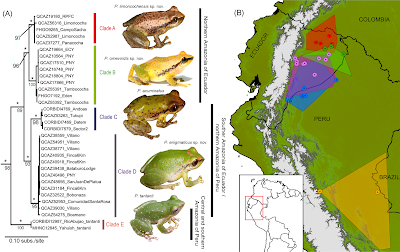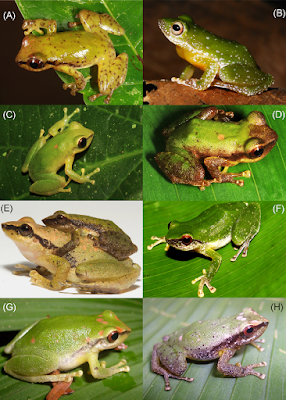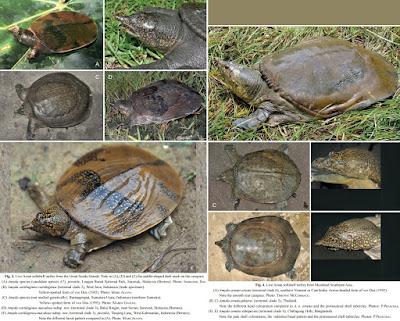Species New to Science's Journal
[Most Recent Entries]
[Calendar View]
Wednesday, March 9th, 2016
| Time |
Event |
| 5:16a |
[Herpetology • 2015] Insights from Integrative Systematics Reveal Cryptic Diversity in Pristimantis Frogs (Anura: Craugastoridae) from the Upper Amazon Basin
 | Fig 1. Phylogeny and distribution of the Pristimantis acuminatus group in the Amazon Basin.
(A) Optimal maximum likelihood tree (log likelihood = -6762.95) inferred from a partitioned analysis of 1997 aligned sites of the 12S, 16S and COI (by codon position) mtDNA genes, showing the phylogenetic relationships among 33 specimens identified as P. acuminatus sensu lato and P. tantanti from the Amazon basin. Clade A = Pristimantis limoncochensis sp. nov., clade B = P. omeviridis sp. nov., clade C = P. acuminatus sensu stricto, clade D = P. enigmaticus sp. nov., and clade E = P. tantanti. Stars denote clades with Bayesian posterior probability values1; numbers below clades represent non-parametric bootstrap support values.
(B) Areas of distribution for species in the complex. Dotted circles = Localities of collection from specimens used for the phylogenetic analyses; Polygons = occurrence areas drawn as minimum convex polygons for each clade based on specimens reviewed in collections (S2 Table). Colors of clades in the phylogenetic tree correspond to colors of polygons and dotted circles on the map.
|
Abstract
Pluralistic approaches to taxonomy facilitate a more complete appraisal of biodiversity, especially the diversification of cryptic species. Although species delimitation has traditionally been based primarily on morphological differences, the integration of new methods allows diverse lines of evidence to solve the problem. Robber frogs (Pristimantis) are exemplary, as many of the species show high morphological variation within populations, but few traits that are diagnostic of species. We used a combination of DNA sequences from three mitochondrial genes, morphometric data, and comparisons of ecological niche models (ENMs) to infer a phylogenetic hypothesis for the Pristimantis acuminatus complex. Molecular phylogenetic analyses revealed a close relationship between three new species — Pristimantis enigmaticus sp. nov., P. limoncochensis sp. nov. and P. omeviridis sp. nov. — originally confused with Pristimantis acuminatus. In combination with morphometric data and geographic distributions, several morphological characters such as degree of tympanum exposure, skin texture, ulnar/tarsal tubercles and sexual secondary characters (vocal slits and nuptial pads in males) were found to be useful for diagnosing species in the complex. Multivariate discriminant analyses provided a successful classification rate for 83–100% of specimens. Discriminant analysis of localities in environmental niche space showed a successful classification rate of 75–98%. Identity tests of ENMs rejected hypotheses of niche equivalency, although not strongly because the high values on niche overlap. Pristimantis acuminatus and P. enigmaticus sp. nov. are distributed along the lowlands of central–southern Ecuador and northern Peru, in contrast with P. limoncochensis sp. nov. and P. omeviridis sp. nov., which are found in northern Ecuador and southern Colombia, up to 1200 m in the upper Amazon Basin. The methods used herein provide an integrated framework for inventorying the greatly underestimated biodiversity in Amazonia.
 | Fig 9. Living specimens of the Pristimantis acuminatus complex and their relatives in the Amazon Basin.
(A) Pristimantis acuminatus, QCAZ 53263, (B) Pristimantis tantanti, CORBIDI 12987, (C-D) night and daylight color variation in Pristimantis limoncochensis sp. nov., QCAZ 52987, (E) amplectant pair of Pristimantis omeviridis sp. nov., holotype female QCAZ 55392 and paratype male QCAZ 55391, (F) Pristimantis padiali, specimen not collected, (G-H) night and daylight color variation in Pristimantis enigmaticus sp. nov., specimen not collected.
Photographs of (B) by V. Durán, (E) by Santiago Ron, (F) by Omar Rojas; all other photographs by H. M. Ortega-Andrade. DOI: 10.1371/journal.pone.0143392 |

H. Mauricio Ortega-Andrade, Octavio R. Rojas-Soto, Jorge H. Valencia, Alejandro Espinosa de los Monteros, Juan J. Morrone, Santiago R. Ron and David C. Cannatella. 2015. Insights from Integrative Systematics Reveal Cryptic Diversity in Pristimantis Frogs (Anura: Craugastoridae) from the Upper Amazon Basin. PLoS ONE. 10(11): e0143392. DOI: 10.1371/journal.pone.0143392
| | 5:30a |
[Herpetology • 2014] Phylogeography of the Asian Softshell Turtle Amyda cartilaginea (Boddaert, 1770): Evidence for A Species Complex  | Fig. 3. Live Asian softshell turtles from the Great Sunda Islands.
Note in (A), (D) and (E) the saddle-shaped dark mark on the carapace.
(A) Amyda species (candidate species A?), juvenile, Loagan Bunut National Park, Sarawak, Malaysia (Borneo). Photo: Indraneil Das.
(B) Amyda cartilaginea cartilaginea (terminal clade 2), West Java, Indonesia (trade specimen). Yellow-spotted form of van Dijk (1992). Photo: Mark Auliya.
(C) Amyda species (not studied genetically). Rantauprapat, Sumatera Utara, Indonesia (northern Sumatra). Yellowspotted form of van Dijk (1992). Photo: Maren Gaulke.
(D) Amyda cartilaginea maculosa subsp. nov. (terminal clade 3), Balai Ringin, near Serian, Sarawak, Malaysia (Borneo). Photo: Indraneil Das.
(E) Amyda cartilaginea maculosa subsp. nov. (terminal clade 3), juvenile, Tanjung Lasa, Kapuas Hulu, West Kalimantan, Indonesia (Borneo). Note the different facial pattern compared to (A). Photo: Mark Auliya.
Fig. 4. Live Asian softshell turtles from Mainland Southeast Asia.
(A) Amyda ornata ornata (terminal clade 6), southern Vietnam or Cambodia. Arrow-headed form of van Dijk (1992). Note the smooth rear carapace. Photo: Timothy McCormack.
(B, C) Amyda ornata phayrei (terminal clade 5), Thailand. Note the different head colouration compared to A. o. ornata and the pronounced shell tubercles. Photos: Peter Praschag.
(D, E) Amyda ornata subspecies (terminal clade 4), Chittagong Hills, Bangladesh. Note the pale shell colouration, the indistinct head pattern and the pronounced shell tubercles. Photos: Peter Praschag. |
Abstract Using up to 2456 bp mtDNA and up to 2716 bp nDNA of fresh samples and short sequences of three mitochondrial genes of historical museum material, we examine the phylogeography of Amyda cartilaginea. This data set provides evidence for the existence of deeply divergent genetic lineages which we interpret as three distinct species, two of which are polytypic. On the Great Sunda Islands, the distribution ranges of the two subspecies of Amyda cartilaginea (Boddaert, 1770) sensu stricto and of an undescribed species match palaeodrainage systems. Amyda cartilaginea cartilaginea occurs in the East Sunda palaeodrainage, with records in eastern Borneo and Java. Also a record from Sulawesi, most probably not representing a native population, refers to A. c. cartilaginea. In the North Sunda palaeodrainage (Sumatra, western Borneo) lives Amyda cartilaginea maculosa subsp. nov., which is described herein. One sample from the Baram river (Sarawak, Malaysia) is genetically highly distinct and represents a new species. We refrain from naming this taxon until more material becomes available for morphological characterization. For the continental populations, we resurrect the species Amyda ornata (Gray, 1861). We identify Asian softshell turtles from the Mekong drainage with the nominotypical subspecies, while the genetically distinct populations from Thailand and Myanmar are assigned to Amyda ornata phayrei (Theobald, 1868). Samples from Bangladesh are also genetically distinct and represent an undescribed subspecies and the first country record for Amyda. Key words: Amyda cartilaginea cartilaginea; Amyda cartilaginea maculosa subsp. nov.; Amyda ornata ornata; Amyda ornata phayrei; Great Sunda Islands; Southeast Asia, Subspecies; Taxonomy; Testudines; Trionychidae.
 | Fig. 3. Live Asian softshell turtles from the Great Sunda Islands.
Note in (A), (D) and (E) the saddle-shaped dark mark on the carapace. (A) Amyda species (candidate species A?), juvenile, Loagan Bunut National Park, Sarawak, Malaysia (Borneo). Photo: Indraneil Das.
(B) Amyda cartilaginea cartilaginea (terminal clade 2), West Java, Indonesia (trade specimen). Yellow-spotted form of van Dijk (1992). Photo: Mark Auliya.
(C) Amyda species (not studied genetically). Rantauprapat, Sumatera Utara, Indonesia (northern Sumatra). Yellowspotted form of van Dijk (1992). Photo: Maren Gaulke.
(D) Amyda cartilaginea maculosa subsp. nov. (terminal clade 3), Balai Ringin, near Serian, Sarawak, Malaysia (Borneo). Photo: Indraneil Das.
(E) Amyda cartilaginea maculosa subsp. nov. (terminal clade 3), juvenile, Tanjung Lasa, Kapuas Hulu, West Kalimantan, Indonesia (Borneo). Note the different facial pattern compared to (A). Photo: Mark Auliya. |
 | Fig. 4. Live Asian softshell turtles from Mainland Southeast Asia.
(A) Amyda ornata ornata (terminal clade 6), southern Vietnam or Cambodia. Arrow-headed form of van Dijk (1992). Note the smooth rear carapace. Photo: Timothy McCormack.
(B, C) ตะพาบน้ำ | Amyda ornata phayrei (terminal clade 5), Thailand. Note the different head colouration compared to A. o. ornata and the pronounced shell tubercles. Photos: Peter Praschag.
(D, E) Amyda ornata subspecies (terminal clade 4), Chittagong Hills, Bangladesh. Note the pale shell colouration, the indistinct head pattern and the pronounced shell tubercles. Photos: Peter Praschag. |
 Uwe Fritz, Richard Gemel, Christian Kehlmaier, Melita Vamberger and Peter Praschag. 2014. Phylogeography of the Asian Softshell Turtle Amyda cartilaginea (Boddaert, 1770): Evidence for A Species Complex. Vertebrate Zoology. 64(2): 229–243.
|
|






